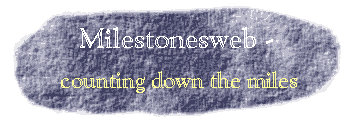

In the distant past, someone must have come up with the idea of inscribing a stone with the distance and placing it for travellers to keep track of their journey. The obvious solution would be a flat stone with the inscription parallel to the side of the road so that travellers in either direction could read it - such as the example shown on the right.
With a little more reflection we can see that improvements are to be had on the design. Make the stone triangular and angle the sides to the road - this makes the stone readable from further away, since the traveller's sightline is less acute. It also makes better use of materials - there are now two faces for the inscription.(left)
Recutting the inscription as it wears or weathers away was a problem, and with the advent of cast iron many milestones acquired cast iron plates to carry the inscription (right) These were attached by drilling a hole in the milestone through which bolts could be used to fix the plate on. Although it does rust on the surface if not painted, cast-iron is surprisingly durable in this application
Taking the use of cast iron a stage further is the milepost, which now presents three sides for lettering. The face parallel to the road was often used to give the distance to London, with the directional information on the side. the post is of a V shaped cross-section, and could either be free-standing or bolted onto an existing worn milestone. This one is mounted against the wall of The Milestone pub in Ipswich, Suffolk.
Some locations demand something more striking, leading to the development of obelisks such as the one on the right, in Nayland, Suffolk. This kind of milestone is in a class of its own - you don't expect to see a whole run of this type and they are produced in all sorts of shapes and sizes.
Home
Milestone Gazetteer by county | milestone
designs
guestbook | books on
milestones | links